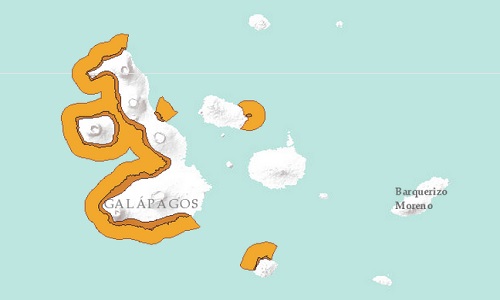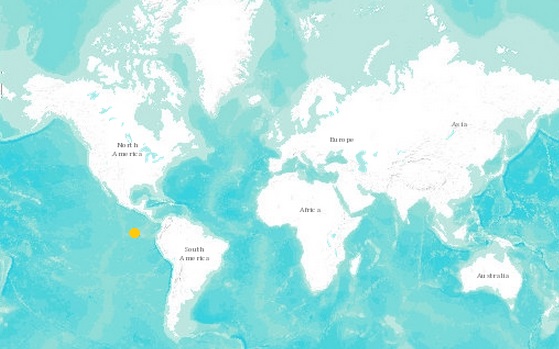0
Taxonomy
-
- Kingdom: Animalia
- Phylum: Chordata
- Class: Aves
- Order: Sphenisciformes
- Family: Spheniscidae
- Genus: Spheniscus
- Species: Spheniscus mendiculus
0
Name
- Scientific name: Spheniscus mendiculus.
- Common name: Galapagos penguin.
Distribution and Habitat
- Galapagos penguins live in the northernmost habitat of all penguin species. They are the only species to live and breed in tropical climate.
- They are found on the equator on the islands of the Galapagos Archipelago. About 95% of the population lives on Isabela and Fernandina Islands and 5% on Bartolomé, Santiago and Floreana Islands. The islands are under the administration of the Galapagos National Park and Marine Reserve.
- Their habitat consists of coastal areas where they can hunt and breed. Cold waters are brought by the Cromwell Currents which also bring abundant food. Volcanic rocks on the islands provide nesting sites.
- They have the smallest range and population size of any penguin species.

Distribution map of the Galapagos penguin. Source: IUCN Red List of Threatened Species
Physical Features
- Galapagos penguins are aquatic flightless birds that have adapted to life in water. They have developed flippers instead of wings spending half of their time in water and the other half on land.
- They are the smallest of the spheniscus genus. Other members of this genus are the Magellanic penguin (Spheniscus magellanicus), Humboldt penguin (Spheniscus humboldti) and the Jackass penguin (Spheniscus demersus).
- The Galapagos penguin is the second smallest of all penguin species in the world after the Little penguin (Eudyptula minor) from Australia and New Zealand.
- They have black head with a narrow white border extending from the corner of the eye to the throat and around the head.
- Black-gray upperparts and white underparts. Adults have scattered black spots of black which is not present in juveniles.
- The black and white coloration is called counter shading which provides camouflage against predators. The white provides camouflage under water for marine predators looking upwards, while the black against birds looking downwards.
- They have a relatively large bill compared to its head. The upper part of its bill and the tip of the lower part are black, the rest of the bill is pink-yellow.
- They use their tails and wings to maintain balance.
Size and Length
- Galapagos penguins average 19 in or 49 cm in length.
- They weigh an average of 5.5 lb or 2.5 kg.
- Females are smaller than males.
Diet
- Galapagos penguins are carnivorous. They eat small marine creatures such as small crustaceans, sardines, anchovies, mullets and mollusks.
Reproduction
- Males reach reproductive maturity between 4 to 6 years old, while females between 3 and 4.
- Before they breed Galapagos penguins molt.
- Males searching for a mate will display bill dueling, grooming and dance rituals.
- They are monogamous for a breeding season.
- They breed throughout the year but the best time is May to June when water is coldest at less than 23˚
- Nests are built in a volcanic depression or a crevice. They nest on Fernandina and Isabela Islands.
- The pair shares the responsibility for incubating the eggs. Incubation lasts 40 days.
- Females lay 4 to 6 eggs during 2 to 3 reproductive periods each year.
- Chicks become independent at 3 to 6 months. Both parents share the responsibility for their care.
- Parent feed their chicks by regurgitating food into their mouths.
Behavior
- They communicate using vocalizations and body movements.
- To stand the strong sun and high temperature on the equator and to keep their body temperature cool they swim in the cold water and pant and stretch out their flippers.
- Galapagos penguins live in colonies of several hundred individuals.
- They hunt in groups but they are territorial when protecting their nest.
Natural Predators
- In the sea Galapagos penguins are prey to sea lions, seals and sharks.
- On land they are prey to Galapagos rats, snakes, hawks, owls and feral cats and dogs that have been introduced to the islands.
Threats
- Galapagos penguins are restricted to a small range with nearly all birds nesting at one location.
- Disturbance of habitat by ecotourism.
- ENSO, El Niño Southern Oscillations, has negative impact on penguin population. It brings warm waters over the central and eastern Pacific Ocean and a decrease in quantity of food.
- The 1982-83 ENSO resulted in 77% loss of population and the 1997-98 resulted in 60%. During this period they do not breed until water temperature and food supplies are restored.
Conservation Status
- The IUCN Red List of Endangered Species lists the Galapagos penguin as an “endangered” species.
- The population of Galapagos penguins is located within the Galapagos National Park and Marine Reserve.
Did you know?
- The northern tip of Isabela Island crosses the equator which means that they occasionally visit the northern hemisphere in the wild.
References and further research
Bird Life International Galapagos Penguin Spheniscus mendiculus
IUCN Red List of Threatened Species Spheniscus mendiculus
University of Michigan Museum of Zoology Spheniscus mendiculus
MarineBio Conservation Society Galapagos Penguin Spheniscus mendiculus
Galapagos Conservancy – Ecosystem Restoration: Increasing the Galapagos Penguin Population
University of Arizona Ecology and Evolutionary Biology – Galapagos Penguin


